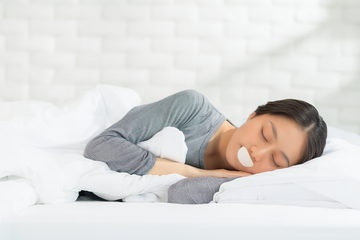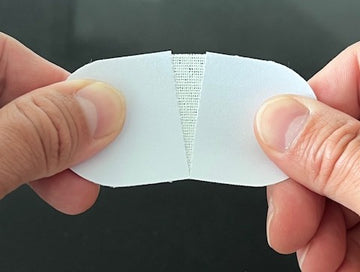Your First Night

Welcome to Mouth-Aid
So… you’ve decided to tape your mouth shut. Brave. Beautiful. Welcome.
If you're reading this, you've made the bold (and slightly strange-sounding) choice to try mouth tape. Good for you. Between 25% to 50% of adults snore, 25% chronically and 45% occasionally. It’s time to put an end to poor sleep.
But now what? Do you just slap it on and call it a night?
Well… basically, yes.
But let’s make your transition a little smoother.

There is a reason you’re a mouth breather
First things first. If you’re a genuine breather there is a reason for this. Our bodies evolve for survival and yours has to.
Maybe you have a deviated septum, allergies, recessed jaw, or blockages in your nasal cavities. Depending on your condition, the transition will come easier or harder depending on the blockages in your nasal passages.

Wear the tape awake before bed
Wearing mouth tape to sleep is starting a new habit.
One of the biggest mistakes people make when starting a new habit is going too hard, too fast. They try to go from zero workouts to hitting the gym four times a week—but that’s not how behavior change works.
It’s best to start off with a small achievable task that seems like a no brainer to allow you to repeatedly complete the habit.
How does this apply to mouth tape? Start with a progression that will work for you. I recommend taping your mouth 10-15 minutes before heading to bed.
Put it on while you’re awake to get comfortable as this helps you get comfortable and signals to your brain: “Hey, we’re safe. We can breathe.”
For the first few nights, focus on getting used to wearing the tape before sleep by journaling, meditation or reading before bed. Once it feels natural, you can start applying it right before bed.

Putting the tape on
We get it. Peeling off the backing can be surprisingly difficult and annoying at first.
Here is the hack:
Pinch both ends of the tape with your thumbs and gently pull. This stretches the strip and splits the backing in two. Way easier.
Apply to a dry, clean mouth. Stick it on your lips, press gently around the edges. Take a few breaths and ease into the tape. Pat yourself on the back, you’ve converted yourself to a mouthtaper.

Your nasal cavities can be retrained
Just like a muscle you don’t use, your nasal passages can atrophy. The good news? With practice, you can retrain it - strengthening your nose’s natural ability to breathe efficiently again
Most people can retrain their nasal passage in 3-4 weeks of using mouth tape to bed.
With consistency and care, you strengthen them. And yes—your body will learn to breathe differently.
Your bedtime routine MATTERS!
People in the personal development world LOVE talking about morning routines.
Yet bedtime routine and quality of sleep play a direct role in how energized and prepared you feel the next morning.
We’ve all been there - sucked into doom-scrolling on our phones. Aim to avoid this!
Ideally, you’ll give your brain a one-hour break from screens before bed, as blue light can suppress melatonin, which signals your body that it’s time to sleep.
Develop a bedtime routine that works for you and stick to it. For me, I floss and brush my teeth, drink water, and usually wind down with a book before putting Mouth-Aid on for the night.

Sleep well. Wake up better
Once you've wrapped up your bedtime routine, tuck yourself in and enjoy a restful night's sleep - with your Mouth-Aid tape on.
At first, the tape might feel a little strange. You might wake up in the night or feel the urge to take it off. Totally normal. Most users adjust within a few nights.
Like any new habit, it takes a little time to stick (yes, pun intended). But once you get through the initial adjustment, many mouth breathers notice real, positive changes in their sleep quality.
In the morning, gently peel the tape off, toss it out, and start your day feeling refreshed.
Sweet dreams 😴
— Your Snore Free Sidekick, Mouth-Aid
P.S. We want to hear about your first mouth taping experiences. Please reach out at wecare@mouthaid.online.
